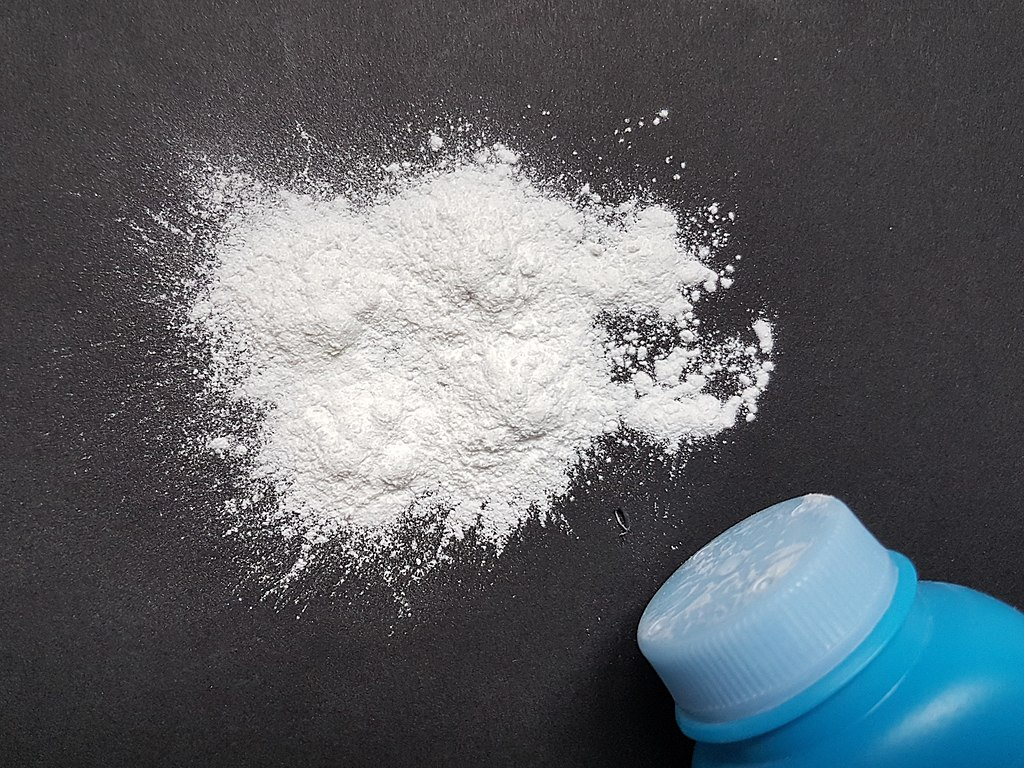Navigating the Talcum Powder Lawsuit: Insights Into the Ongoing Litigation
For decades, the mineral talc has been a ubiquitous element of consumer life, found in products from baby powder to makeup. However, talc comes with a risk of asbestos contamination that can lead to a range of medical issues for consumers. Women are especially at risk for ovarian cancer and other diseases as a result of tiny particles contaminated with asbestos entering their bodies and spreading to reproductive organs.
At Wallace Miller, we know how much a cancer diagnosis can change your life. Not only can the diagnosis itself be devastating, but the medical care required can disrupt your daily routine and cause significant financial strain. If a manufacturer supplied you with a product contaminated with a known human carcinogen, you have a right to hold them liable. They may be financially responsible for your hospital costs, prescriptions, medical bills, and other expenses caused by the exposure.

Contaminated talc is at the center of the suit against Johnson & Johnson. Image by Austin Kirk, Public domain, via Wikimedia Commons.
The legal and medical systems can be overwhelming — but you don’t have to go through the experience of navigating a diagnosis and fighting for compensation alone. The legal team at Wallace Miller has more than 75 years of combined experience helping our clients advocate for their rights. We’re not afraid to fight against large corporations that cause harm to their customers, and we will work tirelessly by your side to achieve justice on your behalf.
Our initial consultations are always free and confidential. Reach out to our office today at 312-261-6193 or fill out our online questionnaire to speak with a member of our experienced and dedicated talcum powder lawsuit team.
Talcum powder lawsuit timeline
February 2024 — Johnson & Johnson is planning to file a third bankruptcy petition in the state of Texas as part of its continued efforts to evade accountability in the talcum powder lawsuit. In its previous two failed attempts, Johnson & Johnson attempted to shift liability to a subsidiary, LTL Management, and then declare bankruptcy on the offshoot company’s behalf in a controversial maneuver called the “Texas Two-Step.” Both petitions were rejected by the courts in New Jersey on the grounds that Johnson & Johnson was not in genuine financial distress. Now, J&J plans to relocate LTL Management to Texas and try again.
The previous bankruptcy attempts by the megacorporation have already resulted in more than two years of delays for plaintiffs.
January 2024 — Johnson & Johnson has agreed to a $700 million tentative settlement with 42 U.S. states. While this settlement does not apply to lawsuits against the company brought by private plaintiffs, it still represents a step forward in the litigation.
December 2023 — Johnson & Johnson is facing more than 50,000 talc lawsuits as part of the consolidated multidistrict litigation (MDL).
October 2023 — A New Jersey appeals court has overruled a $224 million verdict for plaintiffs over issues with expert testimony. A new trial is pending.
October 10, 2023 — Judge Michael A. Shipp has set additional deadlines for the submission of documentation, witness lists, depositions, and bellwether trials for plaintiffs and defendants. Prompt turnaround time is particularly important in this court process, as many plaintiffs have been diagnosed with stage 3 ovarian cancer and may not have time to wait for a lengthy settlement.
August 2023 — Federal Bankruptcy Court Judge Michael Kaplan once again rejects Johnson & Johnson’s attempted bankruptcy.

Image by Pixabay.
August 2023 — Johnson & Johnson refiles their bankruptcy petition, now with a $9 billion settlement proposal.
March 2023 — the Third Court of Appeals rejects the attempted bankruptcy of LTL Management, an offshoot company set up by Johnson & Johnson to manage their liability. The bankruptcy claim by LTL Management resulted in a two-year pause on the talcum powder litigation. During this period, no plaintiffs’ lawsuits claiming harm caused by Johnson & Johnson’s baby powder were able to go forward.
February 2023 — Judge Freda Wolfson retires. Judge Michael A. Shipp is appointed to oversee the talcum powder lawsuit MDL.
December 2022 — The Modernization of Cosmetics Regulation Act is signed by President Joe Biden. The act expands the FDA’s authority to regulate cosmetics and specifically requires standardized testing of talc products for asbestos.
October 2021 — Johnson & Johnson forms LTL Management and transfers its talcum powder liabilities to the new company. LTL Management then declares bankruptcy in an attempt to protect Johnson & Johnson from their legal responsibility.
May 2020 — Johnson & Johnson discontinues sales of its talc-based baby powder in the U.S. and Canada.
July 2018 — A verdict in Missouri awards $4.7 billion to 20 women diagnosed with ovarian cancer, ruling that exposure to Johnson & Johnson’s baby powder led to their diseases. The ruling was upheld by the Supreme Court in June 2021.
Baby powder cancer injury claims
Since the product was first introduced to the market in 1894, defendant Johnson & Johnson (J&J) has marketed its Johnson’s Baby Powder and other talcum powder products as safe to use, even for infants. For decades, women have used both the standard baby powder and specific talc-containing products like Shower to Shower as hygiene products for avoiding moisture and maintaining a clean scent.
In that time, a number of research studies have shown a link between the use of talcum powder and certain types of cancer. Plaintiffs in the talcum powder lawsuit claim that talc products, including Johnson’s Baby Powder, were contaminated with asbestos. The asbestos particles in the talcum powders can travel through the reproductive tract and into the ovaries, where they may lead to cancer. Individuals involved in the lawsuits further allege that J&J knew about the potential asbestos exposure for decades and manipulated scientific data to cover up the truth.
J&J insists that its talc products do not cause cancer. However, more than 50,000 plaintiffs have brought suits against the company, which have been consolidated in a multidistrict litigation (MDL) in the U.S. District Court for the District of New Jersey under Judge Michael A. Shipp.
Wallace Miller is honored to help plaintiffs harmed by J&J’s talc products in their fight for justice. We represent clients who used talcum powder for personal hygiene and developed cancers linked to the female reproductive system as a result.

Image by Pixabay.
What products contain talcum powder?
Talc, the primary ingredient in baby powder, is a naturally occurring mineral composed of oxygen, magnesium, and silicon. After mining, the raw talc is crushed and refined into powder that is used in a wide variety of products. Its ability to absorb moisture and keep skin dry makes it a popular ingredient in baby powder, talcum powder, and beauty products. Especially in cosmetics such as makeup, deodorants, and dry shampoos, it is used to prevent caking, improve texture, and to make a product opaque.
Because talc is mined from the ground, it can sometimes be contaminated by neighboring asbestos deposits. The two minerals often occur naturally in proximity to one another, which increases the likelihood of cross-contamination.
Unlike those who produce drugs or food additives, companies that manufacture and sell cosmetics don’t have to go through the review and approval process set up by the U.S. Food and Drug Administration (FDA). And, because federal regulations consider talcum powder a cosmetic product, talc manufacturers can release their potentially dangerous products to the market without fear of government oversight.
While many cosmetics and baby powders contain talc, Wallace Miller is focusing our legal efforts on two products manufactured by J&J: Johnson’s Baby Powder and Johnson’s Shower to Shower.
Other common products that contain talc are various types of mineral makeup, such as:
- Blush
- Lipstick
- Eyeliner
- Eyeshadow
- Mascara
- Concealer
- Eyebrow pencil
While many companies have begun to reduce the talc in their products, you can also find talc in beauty products including moisturizers, creams, and lotions.
Concerned about your beauty products? SkinSAFE (developed with Mayo Clinic) and the Cosmetic Ingredient Review (chaired by a panel of scientific experts) provide product details and allow you to look up ingredients before you buy.
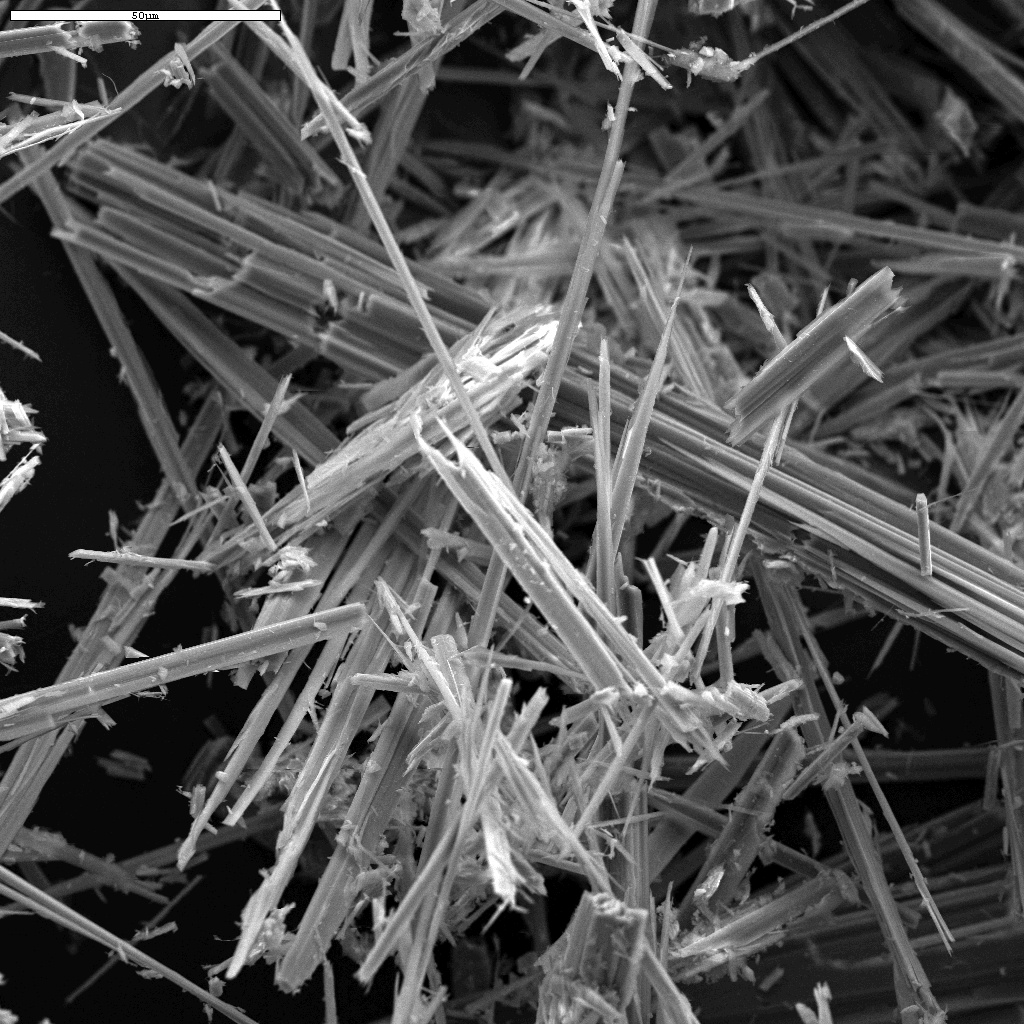
Anthophyllite asbestos as seen through an electron microscope. Image by the United States Geological Survey.
What cancers have been linked to talcum powder?
The claims made by plaintiffs in the talcum powder lawsuits allege that traces of asbestos found in the powder can lead to a number of serious health effects. The International Agency for Research on Cancer (IARC) classifies asbestos as a known human carcinogen; asbestos exposure in a wide variety of forms has been linked to mesothelioma and other serious health effects.
The cancers linked to asbestos exposure in talcum powder may include:
- Ovarian cancer: The uncontrolled growth of abnormal cells in the ovary, which can then spread into surrounding tissues. Ovaries are part of the female reproductive system and produce hormones and eggs.
- Epithelial ovarian cancer: Cancer that starts in the layer of tissue surrounding the ovaries (the epithelial tissue). Epithelial cancer is the most common type of ovarian cancer.
- Fallopian tube cancer: A type of epithelial ovarian cancer that forms in the lining, or epithelial layer, of the fallopian tubes.
- Peritoneal cancer: A type of epithelial ovarian cancer that forms in the layer of tissue that covers abdominal organs.
- Mesothelioma: An aggressive form of cancer that begins in the mesothelium, or the thin tissue layer covering most internal organs.
- Epithelial ovarian cancer: Cancer that starts in the layer of tissue surrounding the ovaries (the epithelial tissue). Epithelial cancer is the most common type of ovarian cancer.
How does talcum powder cause cancer?
Talc that contains asbestos has been identified as carcinogenic to humans by the IARC. There is no safe level of asbestos exposure, and any amount of asbestos found in talc products can cause cancer in those using it.
Several studies have indicated that the use of talcum powder on genitals can increase the risk of developing cancer over time, even if the talc is not contaminated with asbestos. When applied for personal hygiene, the talc powder can travel through the fallopian tubes and settle in the ovaries.
The presence of the talcum powder can then cause inflammation, which in turn increases the likelihood of the formation of cancer cells. While research is ongoing on the potential link between talcum powder and cancer, the IARC has classified talc used for genital applications as “possibly carcinogenic to humans.” Ovarian cancer is one of the deadliest forms of cancer, due to the fact that diagnosis is often missed until the cancer has progressed to an advanced stage or spread to other areas of the body.

Image by Pixabay.
Plaintiffs in the ongoing talcum powder lawsuits allege both that several of J&J’s products containing talc are associated with a higher risk of cancer and that J&J was aware of this link for decades. The talc powder litigation claims that Johnson & Johnson failed to warn consumers of this risk and instead prioritized their revenue stream by continuing to market and sell these hazardous products.
We believe that J&J needs to be held accountable for the risk caused to countless women over decades of talcum powder use. The team at Wallace Miller is hard at work to secure recoveries for our clients who have been diagnosed with ovarian cancer and other health conditions as a result of their exposure to talcum powder.
Understanding the science on talcum powder and ovarian cancer
The first studies to examine the link between talcum powder and ovarian cancer, as well as other forms of cancer of the female reproductive system, took place in the 1970s when researchers found talc powders in ovarian tumors. Talc manufacturers consistently suppressed these results in order to avoid impacting their products.
From 1971 to the early 2000s, tests found small amounts of asbestos in both raw talc and finished talcum powders produced by J&J. Company representatives discussed the findings and the potential issue they posed to its products, but ultimately did not disclose the results to regulators or the public.
Over 1972 and 1973, three tests found asbestos in J&J products, one of which labelled the amount as “rather high.” The corporation informed the FDA that no asbestos had been found in their samples over this period, effectively hiding the data linking talcum powder to cancer from the regulatory body.
As early as 1997, women suffering from ovarian cancer began to bring lawsuits against J&J’s baby powder. At the time, Johnson & Johnson refused to provide internal documents and the courts opted not to compel them to do so. The lawsuits stalled, and countless women over the decades have died never knowing what caused their ovarian cancer.
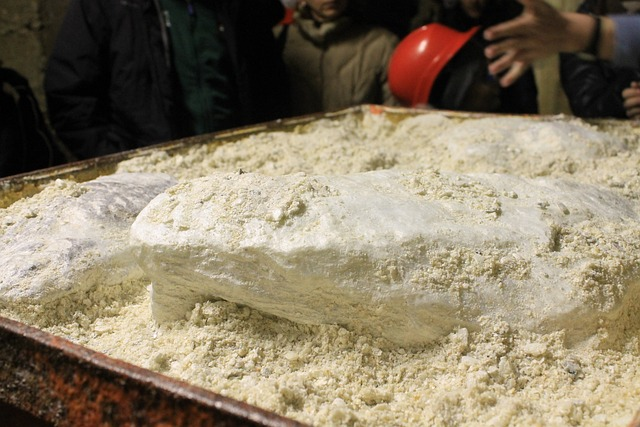
Image by Pixabay.
Johnson & Johnson has also doctored scientific data to conceal the potentially adverse effects of talcum powder. Emails unsealed as part of the baby powder lawsuit included an exchange discussing the results of a scientific study that pointed to the risks of asbestos in talc. Johnson & Johnson urged the scientists behind the study to change the report and bury the worrying information. As a result, the FDA did not receive the appropriate information on asbestos exposure.
More internal documents demonstrate J&J employees worrying over how to handle the potential asbestos contamination of talc. When the FDA proposed more rigorous testing methods, Johnson & Johnson successfully convinced the agency to allow the industry to self-regulate via voluntary guidelines rather than official limits on asbestos content. Johnson & Johnson sponsored studies designed to improve the reputation of talc and baby powder in the U.K. and the U.S., in many cases telling the researchers what results they wanted and hiring a ghostwriter to officially draft the journal article to their standards.
While this corporate influence over scientific examination has limited the results linking asbestos to talc, the research that has been published has proved troubling for the company. Information collected after the talc mines run by J&J for decades changed hands indicated that those mines contained asbestos — and that some records of mine inspection were destroyed before the handover.
If you have ovarian cancer, mesothelioma, or another medical condition and believe it may be from using talcum powder, reach out to the experienced baby powder lawyers at Wallace Miller today for a confidential and free consultation. Our office can be reached at 312-261-6193 or by filling out our online questionnaire. We’ll help you review the circumstances and determine whether you’re eligible to participate in the talc litigation.
Why has the lawsuit taken so long? J&J’s bankruptcy attempt
While many mass tort litigations take several years to resolve, the talcum powder lawsuit against Johnson & Johnson has been bogged down by unusual delays. This is in large part due to an attempt by J&J to avoid financial responsibility for their talcum powder lawsuits through a maneuver legal experts call the “Texas two-step.”
A loophole in the merger laws of some states allows corporations dealing with potentially expensive lawsuits to create a subsidiary via a divisive merger. The corporation then assigns all of its liabilities — including litigation claims — to the new company and has that company declare bankruptcy.
As soon as a petition for bankruptcy is filed, all lawsuits against that company are automatically stayed, or paused. This stay also applies to any parent companies. The law is designed to allow for companies dealing with genuine financial distress to reorganize their debt under a bankruptcy judge. In theory, companies then come up with a plan to pay out any creditors as part of their reorganization.
However, when companies like Johnson & Johnson use this tactic, it effectively results in an offloading of debt at the expense of plaintiffs, as the amount these individuals will make from a bankruptcy deal is almost always less than that from a settlement.
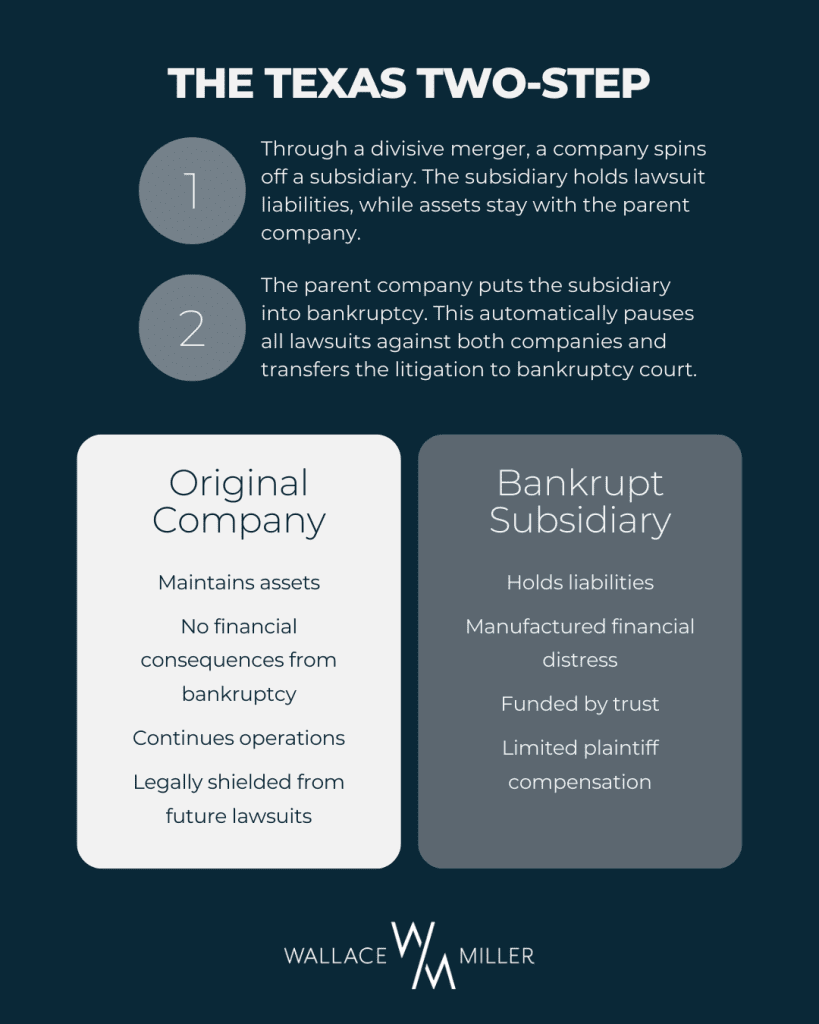
J&J created subsidiary LTL Management in 2021, shifted its baby powder lawsuit liability to the new company, and immediately declared bankruptcy on its behalf. Through the bankruptcy court, they proposed a global settlement of $2 billion, which would have resulted in significantly lower settlements for plaintiffs had it been accepted.
Courts rejected the attempt on the grounds that LTL Management, as part of J&J, had no real financial distress. The corporation tried to declare bankruptcy again, this time with a $9 billion settlement proposal, which in turn was rejected by the courts in July 2023, who ruled that the company’s continued attempt to declare bankruptcy on behalf of LTL Management was in bad faith.
While the bankruptcy gambit was eventually rejected, it resulted in over two years of delays for plaintiffs, many of whom are dealing with life-threatening illnesses. In this time, multiple plaintiffs have died waiting for a decision, while others continue to live with cancer.
J&J talc recall and products pulled
In October 2019, Johnson & Johnson issued a recall on approximately 33,000 bottles of its baby powder in the United States. This decision came after the FDA advised finding trace amounts of asbestos in one of the manufacturer’s bottles. After conducting its own research, however, J&J announced that it hadn’t found any evidence of asbestos.
After learning of the recall, Walmart, CVS, Rite Aid, and other retailers decided to remove talc-based products from their shelves.
The following year, J&J opted to end the sale of its talc-based baby powders entirely in the U.S. and Canada. The corporation maintains that these products are safe to use and says the recall is due to “changes in consumer habits and fueled by misinformation around the safety of the product.”
How much is a talcum powder lawsuit case settlement worth?
If you have used baby powder for personal hygiene and have been diagnosed with ovarian cancer or another serious health condition, you might be able to file a lawsuit against the manufacturer. In order to prove your case, you and your law firm must provide substantial evidence of the link between your cancer diagnosis and the product you used. In the baby powder lawsuits we take on, Wallace Miller examines medical records, health history, product issues, and your specific circumstances to build the strongest possible case against the manufacturer.
Mass tort litigations like the one currently in progress against Johnson & Johnson combine multiple lawsuits brought by different plaintiffs into a single legal action. All lawsuits in a multidistrict litigation are brought against the same defendant or set of defendants, which helps make the process more efficient for everyone involved.
Under this system, the monetary award of a potential settlement or verdict isn’t the same for everyone. Instead, awards depend upon the circumstances of a plaintiff’s case. In some litigations, plaintiffs are grouped for settlement based upon certain key factors in their cases, and a tier-based system may be set up in order to compensate individuals based on their level of injury.

Image by Pixabay.
Because this is a civil case, there is no criminal punishment for defendants. Instead, a settlement or verdict is designed to help financially compensate plaintiffs for the harms that they suffered. Talc lawsuit compensation might apply to a variety of damages including:
- Emotional distress
- Medical bills
- Lost wages
- Lost earning capacity
- Out-of-pocket expenses
- Pain and suffering
- Loss of enjoyment of life
Some litigations also result in punitive or exemplary damages, which are designed to punish a defendant for overtly harmful actions. In order to receive this form of compensation, the plaintiff’s legal team must provide evidence of gross negligence, disregard for the safety of others, or intentional harm by the defendant.
How long do I have to file a baby powder lawsuit?
The amount of time you have to file talcum powder lawsuits depends on your state. Some states have a one-year statutory time period, while others allow plaintiffs to file their lawsuits within a five-year period.
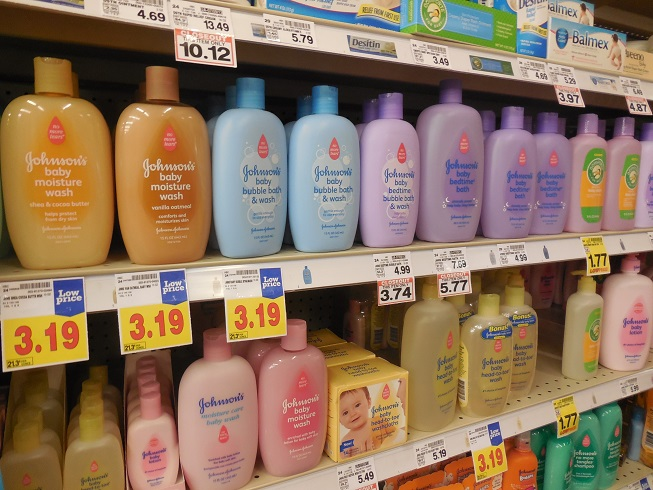
A selection of products from the Johnson Baby line. Image by ParentingPatch, CC BY-SA 3.0, via Wikimedia Commons.
Wallace Miller will review the laws in the state where you reside to determine how much time you have to initiate your lawsuit against the manufacturer. Generally speaking, the timeframe begins on the date of your cancer diagnosis or medical condition from asbestos exposure. Some states have specific exceptions that allow plaintiffs to pause the clock or delay the point at which the timeframe begins.
However, if you run out of time in your state’s statute of limitations, you could lose your right to pursue compensation at all. If you suspect that you may have developed ovarian cancer as a result of talc-based baby powder, it’s crucial that you reach out to a legal representative to determine the best course of action as quickly as possible.
See if you qualify for a talcum powder lawsuit
Individuals may be eligible to participate in the talc powder lawsuits if they developed a cancer related to asbestos exposure after use of J&J’s talcum powder. While there are a number of companies that have been accused of exposing consumers to asbestos contamination in their talc products, Wallace Miller is specifically pursuing cases against Johnson & Johnson.
In order to be eligible, plaintiffs must have a diagnosis of ovarian or other reproductive cancer and must have used a J&J talc-based baby powder for a significant length of time. Our firm is specifically taking on talcum powder cases related to J&J Baby Powder and J&J Shower to Shower.
Talk to Wallace Miller
The legal team at Wallace Miller is proud to represent plaintiffs in mass tort litigations including the talc lawsuits across the U.S. Our law firm is focused on protecting the victims of negligence and fraud through consumer protection, product liability, employment, environmental and toxic damage, and personal injury litigation.
We know that there are many choices available to you when looking for a lawyer to represent you in cases like the talcum powder cancer lawsuits. What sets us apart from other firms is our commitment to our clients, our ability to handle complex high-stakes litigation, and our outstanding track record of success. We only take on cases that our firm has faith in—those that can make a difference in our clients’ lives.

Left to right: Nicholas P. Kelly, Edward A. Wallace, Molly Condon Wells, Mark R. Miller, Jessica Wieczorkiewicz, Timothy E. Jackson.
Questions about your potential talc litigation? Call our office at 312-261-6193 or fill out our online questionnaire for a confidential and free consultation in minutes.


